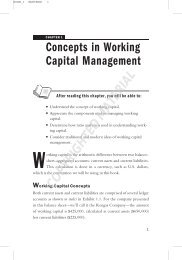ISSUE 5 2008 - Sweet & Maxwell
ISSUE 5 2008 - Sweet & Maxwell
ISSUE 5 2008 - Sweet & Maxwell
Create successful ePaper yourself
Turn your PDF publications into a flip-book with our unique Google optimized e-Paper software.
Crim. L.R. Public Nuisance Injunctions Against On-Street 361<br />
statute—almost everything that endangered public health and safety had become<br />
punishable as a specific statutory offence. Logically then, Spencer argued that the<br />
PNI should have been rendered obsolete, and that over the last 100 years the law<br />
had been, to a certain extent. Yet, he observed that almost all the prosecutions for<br />
public nuisance during the mid decades of the 20th century had been either where<br />
the defendant’s behaviour amounted to a statutory offence typically punishable<br />
with a small penalty and where the prosecutor had wanted:<br />
‘‘. ..a bigger or extra stick to beat him with or where the behaviour is not so<br />
obviously criminal at all and the prosecutor [could] not think of anything else<br />
to charge him with.’’ 60<br />
Spencer’s assertions certainly have some value in the context of the use of PNIs<br />
against sex workers; it is well known that the offences of loitering and soliciting<br />
are punishable by fine only under the Street Offences Act 1959 61 and thus the<br />
legislation offers little deterrent value. However, as Ashworth questioned in his<br />
commentary on Goldstein in the Court of Appeal, 62 the law on public nuisance may<br />
be a ‘‘useful stop gap’’ for prosecuting behaviour that is annoying to the public<br />
and which results in a low maximum penalty, but is this course of action right<br />
Should the law contain this ‘‘catch all’’ offence And, given that the offence is so<br />
broad and vague, is it not appropriate and right that the court should be bound<br />
by the statutory maximum for the offence committed rather than handing out<br />
discretionary penalties in this way 63 Particularly, as Ashworth goes on to point<br />
out, that in 1976 the Law Commission argued for greater certainty of the definition<br />
and made the point that:<br />
‘‘. ..if new forms of wickedness should arise, the approach most consistent<br />
with the rule of law is for Parliament to create new offences ...’’ 64<br />
The House of Lords has recently shed light on some of the issues raised by<br />
Ashworth. In Rimmington and Goldstein 65 the House considered the essential<br />
elements of the offence of public nuisance. As already noted, Lord Bingham in the<br />
leading judgment considered that the public generally or an unnamed section of<br />
it had to be affected. 66 Furthermore, with regard to the appropriate use of public<br />
nuisance law Lord Bingham stated that he was swayed by Spencer’s argument that<br />
the expansion of statutory law had rendered the offence obsolete. 67 Nevertheless,<br />
Lord Bingham, Lord Rodger and Baroness Hale all reiterated what has been said<br />
many times in the House of Lords, namely that the court’s purpose was not to<br />
conduct a law reform exercise—the court did not have the power to abolish offences<br />
or create new ones, this was a matter for Parliament. 68 However, Lord Bingham<br />
60 Spencer, ‘‘Public Nuisance’’ (1989) 48 C.L.J. 55 at 77.<br />
61 The penalty of imprisonment being removed under s.71 of the Criminal Justice Act<br />
1982.<br />
62 Ashworth, [2004] Crim. L.R. 303.<br />
63 Ashworth [2004] Crim. L.R. 303 at 304.<br />
64 Ashworth [2004] Crim. L.R. 303, cited at 305.<br />
65 [2005] UKHL 63; [2006 1 A.C. 459.<br />
66 [2005] UKHL 63; [2006 1 A.C. 459 at [37].<br />
67 [2005] UKHL 63; [2006 1 A.C. 459 at [37].<br />
68 [2005] UKHL 63; [2006 1 A.C. 459 at [31], [54] and [58] respectively.<br />
© SWEET &MAXWELL






